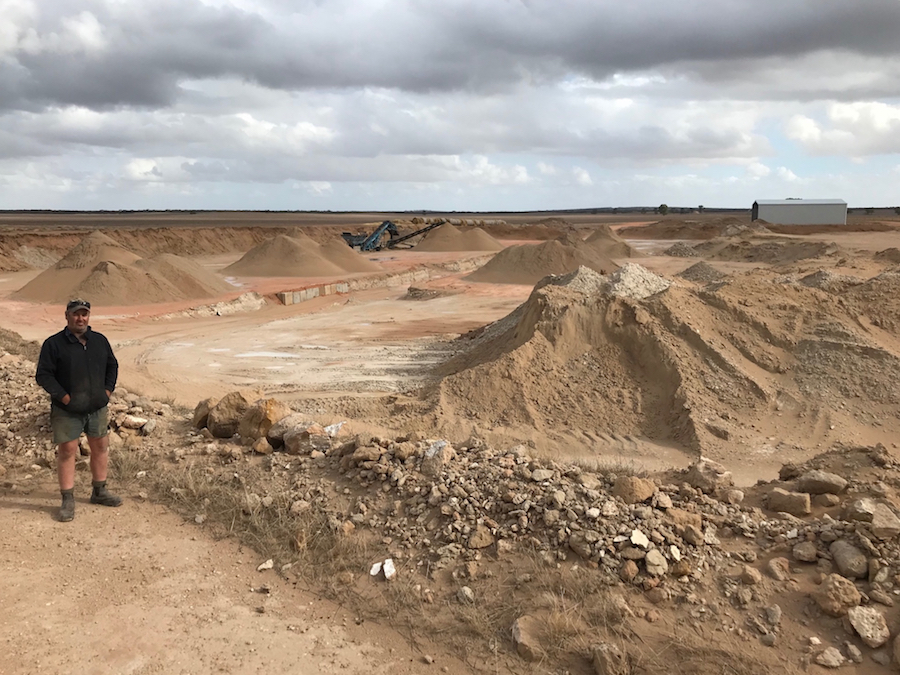Given widespread soil acidification, South Australian grower Scott Crettenden is helping reduce the lime deficit on the Eyre Peninsula by establishing a lime sand mine on his 3075-hectare grains-based business near Karkoo.
Acidic soil across more than 186,000ha or seven per cent of agricultural land on the Lower and Eastern Eyre Peninsula is estimated to cost the region up to $19 million a year in production losses. Soil acidification is a natural process in productive agricultural systems, but research shows it is occurring faster due to modern farming practices, particularly high nitrogen fertiliser application rates.
Primary Industries and Regions SA (PIRSA) research predicts that more than 21,000 tonnes of applied lime is required per year to maintain soil pH on the Eyre Peninsula and, if this is not achieved, soil acidification could spread to another 509,000ha in the next 20 to 50 years.
However, there has been a shortfall in meeting this annual regional target for many years. Since 1999, lime applications have only covered about 77 per cent of the estimated acidic topsoil area. This has led to a cumulative lime deficit, with an extra 213,000t of applied lime needed just to raise the pH of acidic topsoils to the critical level of 5.5 when measured in calcium chloride.
But a fightback has begun. Increased lime sales in the region, estimated at 62,000t in both 2018-19 and 2019-20, have started to reduce the deficit.
Contributing almost half of this (about 25,000t a year) for the past four years have been the Crettendens – Scott, Julie and their son Jack – who have established a lime sand mine on one of their cropping properties.

Lime sales from the 2ha mine on Scott Crettenden's property at Karkoo, SA, total about 100,000 tonnes. Photo: Julie Crettenden
The new mine, EP Lime Sand, has been operating since 2017 and is one of four lime sand mines on the peninsula. The other three mines are located on the Lower Eyre Peninsula at Coffin Bay, Port Lincoln and Coulta.
The Crettendens’ mine at Karkoo is on the Central Eyre Peninsula, which has made the soil amendment more accessible and cost-effective for the region’s central and northern growers.
Freight cost is an important consideration since this can exceed the actual cost of the lime, Scott says. For instance, growers at Cleve might pay about $12.50/t for lime sand, but the cost of freighting this 140 kilometres from the Lower Eyre Peninsula might be more than $20/t, he says.
Scott says the mining operation originated from the chance observation that the lime sand being unloaded from a mine near Coffin Bay resembled the calcareous soil on one of his farms. Subsequent soil pH testing and exploration with an excavator showed the farm’s lime sand deposit had the potential to be developed into a mine. Tests showed lime sand extracted from the site has a relatively high neutralising value of 85 to 95 per cent.
Capital investment in EP Lime Sand was about $400,000 and the enterprise is expected to return a profit for the first time in 2021 – its fifth year of operation – with lime sales surpassing 100,000t.
Their new role as lime suppliers aside, the Crettendens grow canola, wheat, barley, lupins and field peas on four properties (owned and leased) in the Karkoo district, about 20km north of Cummins.
The mine covers 2ha, with a further 22ha pegged for lime sand extraction in the future. Scott says the mine is now part of a “retirement plan” for himself and Julie, as well as potentially providing for the family’s next four or five generations.
More information: Scott Crettenden, 0427 767 024, jcretty@telstra.com

























































